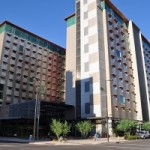Note: Below is some good writing, which obviously means that it isn’t mine… Please enjoy a wonderful piece on ASU’s role in the development of Downtown Phoenix written by Beth Wischnia. I’ll be back next week with some fresh work. — Sam
The once-lifeless capital city of Arizona has taken on a new look and feel recently, complete with a bustling Arizona State University campus in the heart of Downtown. The influx of students on ASU’s Downtown Phoenix campus has directly affected the development of Phoenix.
The campus includes nationally recognized schools such as the Walter Cronkite School of Journalism and Mass Communication and the College of Nursing and Health Innovation. The campus opened in fall 2006, however it was when the Cronkite School opened in fall 2008 that many more students relocated to Phoenix.
Paul Martinez, manager of local restaurant Hanny’s
, said the Downtown Phoenix campus has brought multiple businesses to the community because of the “youth’s energy.”
A Starbucks is in operation on the first floor of Taylor Place and Hsin, a Chinese restaurant, is expected to open in Taylor Place in the near future. Other recent additions to the Downtown Phoenix area include Fair Trade Café and the Phoenix Public Market Urban Grocery and Wine Bar.
Arianna Heet, a sophomore nursing major, has been working at Starbucks in Taylor Place for more than a year. The job sparked her interest because of the “convenience factor”, which allowed her to wake up and walk downstairs to work. In addition to the convenience factor, Heet said she enjoys the atmosphere of the student-friendly on-campus Starbucks as opposed to off-campus locations.
“We have a different dynamic,” Heet said. “We have a strong student-based business.”
Armark, the company that manages the various dining options in Taylor Place, owns the location in Taylor Place, unlike most Starbucks. Heet said the location she works at is a licensed store and not a corporate store. The Taylor Place baristas are employed by Armark and simply buy their product from Starbucks.
“It’s essentially the same business, but run by another company,” Heet explained.
Hanny’s, an Italian-inspired restaurant located just a few blocks away from the Downtown Phoenix campus, draws in customers by combining great food and service with a “historic piece of property,” Martinez said.
The building that is now home to Hanny’s was built in 1947 and underwent a restoration process that took three years. In addition to the unique building’s historical significance, the location is ideal, as it is located adjacent next to the area’s developmental milestone, the light rail.
“The light rail and us were opening about a month apart,” Martinez explained. “It was exciting to have that advancement next to that historic piece of property.”
Lenni Rosenblum, a sophomore journalism student, lives at Taylor Place because she was elected into a leadership position in a residential program. Rosenblum has been living at Taylor Place since the building opened in fall 2008 because of its convenient location. While she enjoys living Phoenix because of what it has to offer, she recognizes there is room for improvement in the development of the area.
Despite some new development in Phoenix, many students who lived at Taylor Place last year chose to live in Tempe this year. Sophomore communications major Amy Gauvin said that part of the reason she no longer lives in Downtown Phoenix is because of the lack of city development in comparison to Tempe.
“After class you can walk to Mill and go shopping, or you can go to Barney’s and get food and go to happy hour. Downtown Phoenix doesn’t offer any of that,” Gauvin said. “I would literally go to class then go back to my dorm until my next class.”
City of Phoenix Mayor Phil Gordon addressed the effect the students have had on the Phoenix community during his State of Downtown address on Nov. 17, 2009 in the city’s new Civic Space park, which was built by a partnership between the city of Phoenix and ASU.
“I want to highlight the steady heartbeat of Arizona State University, which continues to pump life into Downtown Phoenix, continues to generate revenue to the state,” Gordon said, “and continues to do what universities are supposed to do: educate our residents and prepare them to change the world for the better.”
“ASU has brought that fun, youthful life back to Downtown that we didn’t have before,” Martinez said. “We are trying to help pioneer the movement of revitalizing Downtown by taking a local business owner, restoring a building and giving people a place to congregate.”
Samuel Richard, a senior nonprofit leadership and management student, calls himself a “defacto community activist” in Downtown Phoenix. Richard lives and works in the community. He also was part of the team that reimagined the Downtown Phoenix Journal in January of 2009 and is a weekly contributor. He is optimistic about the future of Phoenix because he said that community development takes time.
“Our civic and business leaders have showed a renewed interest in developing the heart of our city,” Richard said. “Thankfully, ASU has been able to play a large part of this renaissance.”
“The area is now seen as a stable, desirable place for the community to be,” Panetta explained. “It’s more attractive for those who might want to live in the area or open a business.”
Also pioneering the revitalization of Downtown Phoenix is CityScape, a multi-use destination blocks away from the Downtown Phoenix campus that will feature retail, restaurants and entertainment. The complex will feature The Breakfast Club
, a taqueria bar, Lucky Strike Lanes and an Urban Outfitters, to name a few.
John Matthews, senior leasing associate of RED Development for CityScape, attributes snagging the prime, central location to being at the right place at the right time.
“After reviewing what the city and state had done with getting the ASU campus Downtown, the time seemed to be right,” Matthews said. “Rarely do you get three blocks in the center of a downtown that are available to develop.”
Matthews said the students on the Downtown Phoenix campus were like a “built-in population”, which is an additional reason CityScape is in Phoenix.
“It’s a huge benefit being near a university campus,” Matthews said. “That, and the diversity downtown has to offer.”
Panetta said the ASU Downtown Phoenix campus acts as a “catalyst for development” in an area that was previously underutilized. He explained such a high concentration of students in a relatively compact area creates an economic effect on the community.
Panetta said the indirect impact students have had far exceeds the direct impact.
“The area is now seen as a stable, desirable place for the community to be,” Panetta explained. “It’s more attractive for those who might want to live in the area or open a business.”
“With an increase in the student population comes an increase in the number of students who will locally rent apartments, go out to dinner and attend local entertainment events, for example,” Rosenblum said
Gordon and Martinez said that ASU’s existence Downtown has helped the city appeal to potential Phoenicians who are looking for an enriching environment to live in.
“We have seen a huge surge of people interested in the Downtown area whose businesses were once solely located in the Scottsdale area,” Martinez said. “They’re starting to branch our because they see more people focusing on Downtown.”
“It’s [ASU] attracted…businesses, restaurants and galleries,” Mayor Gordon said.
“ASU has been in Tempe since 1885, and in Downtown Phoenix since 2006,” Richard explained. “If the community at-large can gain a little perspective and patience, our future will be brighter.”
Martinez said that with increased student population comes increased activity in various businesses located in the area.
“Anytime that you bring in the youth and that kind of energy, especially in large amounts, businesses tend to flourish as they strive to provide for the youth,” Martinez explained. “ASU brought dollars and young energy to support and help the Downtown area grow.”
Arizona State University has “long-range plans” in place to accommodate the projected student growth rate at each campus. Panetta said plans include retail opportunities and more student housing, adding there has been a strong trend for convenient food spots on and near campus.
“Additional retail opportunities will likely emerge in the campus and neighborhood, as well as office and residential projects that will desire proximity to the Downtown campus and the energy and activity it generates as well as the market stability it can help foster,” Panetta said.
Richard said it is a combination of multiple sources that creates a successful Downtown area. Additionally, all major development takes time.
ASU President Michael Crow spoke about the Downtown Phoenix campus during a forum held on Dec. 1, 2009. Crow explained how the city of Phoenix and ASU Downtown have an ideal partnership.
“The Downtown campus is a perfect example of a university and a city with objectives that overlapped with each other,” Crow said. “The city was looking for enterprise and we were looking to expand from the Tempe campus.”
Crow added that there are plans for expanding the Downtown campus’ programs and facilities because it has proved to be a successful campus so far. Additional future plans include moving the Sandra Day O’Connor College of Law Downtown, building a third residence hall and creating more retail space.
“We’re at the end of phase one,” Crow said. “We need to finish our planning for phase two.”
Contact Beth at beth.wischnia@asu.edu.






You make me laugh. The taxpayers of Phoenix were bamboozled into this. They were hoodwinked by Gordon and are saddled with debt to satisfy Michael Crow’s grand ambitions. ASU is not the panacea you think. It is a below average school, always has been and always will be.